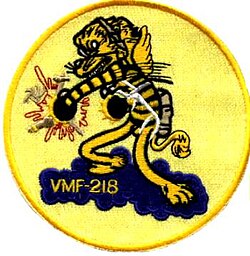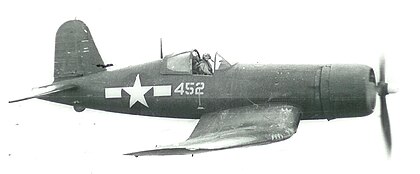VMF-218
| Marine Fighting Squadron 218 | |
|---|---|
 VMF-218 Insignia | |
| Active |
|
| Country | United States |
| Allegiance | United States of America |
| Branch | United States Marine Corps |
| Type | Fighter squadron |
| Role | Air interdiction Close air support |
| Part of | Inactive |
| Nickname(s) | "Hellions"(WWII) "Firebirds"(Post-war) |
| Engagements | World War II * Philippines Campaign (1944–45) |
| Aircraft flown | |
| Fighter | F4U-4 Corsair FJ-4B Fury F9F Cougar |
Marine Fighting Squadron 218 (VMF-218) was a reserve fighter squadron of the United States Marine Corps that was originally activated during World War II. Known as the "Hellions", they flew throughout the South Pacific but saw the majority of their fighting during the Philippines Campaign (1944–45). The squadron was credited with downing 18 enemy aircraft during the course of the war.
History[edit]
World War II[edit]
VMF-218 was organized at Marine Corps Air Station Mojave, California on 1 July 1943 and officially commissioned 15 September 1943. They departed the United States in December 1943 on board the USS Barnes (CVE-20) and arrived at Espiritu Santo on 5 January 1944. Their first combat action took place on 15 February when they covered the allied landing on Green Island. On 27 April the squadron moved to Green Island where they remained until November.[1] During their time on Green Island the squadron was one of a number of Marine squadrons that let a then civilian contractor Charles Lindbergh fly strikes against the Japanese garrison at Rabaul.[2]

In November they moved to Leyte to take part in the campaign to retake the Philippines. December 1944 would see the squadron as part of Task Force 38 in the Philippine Sea conducting strikes against Southern Luzon. During December they also patrolled the air over shipping in Leyte Gulf and Ormoc Bay flew cover over American convoys in various Philippine waters, escorted South Pacific Combat Air Transport (SCAT) planes over Ormoc where they had dropped supplies to ground troops, flew cover for Army ground forces on Mindoro and Cebu Islands; had covered the landing by Army troops at Zamboanga, chalked up a number of close support missions on Mindanao, escorted rescue planes and transport planes to Mindanao, provided air cover for SBD Dauntless strikes and regularly took part in combat air patrols.[3] [4] From Tacloban the squadron took part in escorting naval convoys, close air support (CAS) and attacks on Iliolo. On 10 March 1945, VMF-218 covered the allied landings at Zamboanga where they would then be based. From the airstrip at Zamboanga the squadron flew CAS at Capisan and conducted strikes against Bongao and Jolo. April would see more strikes against Cotabato, Parang and Malabang and there would be continued strikes against Mindanao until the surrender of Japan.

Following the war VMF-218 spent a year in China flying in support of the 1st Marine Division during their occupation to surrender of Japanese forces and provide security for the coastal cities against Communist Forces. On 27 April 1946 the squadrons pilots and 20 Vought F4U Corsairs left Guam aboard the escort carrier USS Bairoko. The pilots were embarked to fly the planes to Qingdao, China for delivery to VMF-211. They made it to the southeast of Shanghai on 8 May and flew off the embarked aircraft the next day.[5] During their time in China the squadron flew out of Nanyuan Field near Beiping. Following their year in China the squadron returned to Guam where they would de deactivated as part of the post-war drawdown of forces on 31 December 1949.[6]
Reserve years[edit]
The squadron was reactivated in the Marine Corps Reserve in the 1950s and were based out of Naval Air Station Willow Grove near Philadelphia, Pennsylvania. The squadron was decommissioned on 30 September 1962.[7]
Notable former members[edit]
Gallery[edit]
-
Capt's Herb Person and Don Bean Collection of Capt Frank Harriman USMCR
-
Squadron members Collection of Capt Frank Harriman USMCR
-
Officer's Mess - Tacloban Island Collection of Capt Frank Harriman USMCR
Unit awards[edit]
A unit citation or commendation is an award bestowed upon an organization for the action cited. Members of the unit who participated in said actions are allowed to wear on their uniforms the awarded unit citation. VMF-218 was presented with the following awards:
| Ribbon | Unit Award |
| Navy Unit Commendation | |
| Asiatic-Pacific Campaign Medal | |
| World War II Victory Medal | |
| Navy Occupation Service Medal | |
| China Service Medal | |
| National Defense Service Medal |
See also[edit]
- United States Marine Corps Aviation
- List of active United States Marine Corps aircraft squadrons
- List of decommissioned United States Marine Corps aircraft squadrons
Notes[edit]
- ^ Sherrod 1952, pp. 462.
- ^ Tillman 2001, pp. 68.
- ^ Chapin (1979). . . . And A Few Marines: Marines in the Liberation of the Philippines. Retrieved 21 February 2009.
- ^ Chapin 1979, pp. 25.
- ^ Francis, Timothy L. (14 December 2005). "Bairoko". Dictionary of American Naval Fighting Ships. Retrieved 21 February 2009.
- ^ Rottman 2002, pp. 442.
- ^ "United States Marine Corps Muster Rolls - 1962" (PDF). NARA. United States Marine Corps. p. 58. Retrieved 23 November 2023.
References[edit]
- Bibliography
- Chapin, Capt John C. (1997). ....And a Few Marines: Marines in the Liberation of the Philippines. Marines in World War II Commemorative Series. Washington, D.C.: Marine Corps Historical Center, United States Marine Corps. Retrieved 19 February 2009.
- Rottman, Gordon (2002). U.S. Marine Corps World War II Order of Battle - Ground and Air Units in the Pacific War, 1939 - 1945s. Greenwood Press. ISBN 0-313-31906-5.
- Sherrod, Robert (1952). History of Marine Corps Aviation in World War II. Washington, D.C.: Combat Forces Press.
- Tillman, Barrett (2001). Corsair: The F4U in World War II and Korea. Annapolis, Maryland: Naval Institute Press. ISBN 1-55750-994-8.
- Web
- "Marine losses in the December 18, 1944 Pacific Typhoon". Washington, D.C.: Naval Historical Center, Department of the Navy. Retrieved 19 February 2009.










